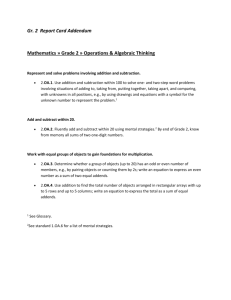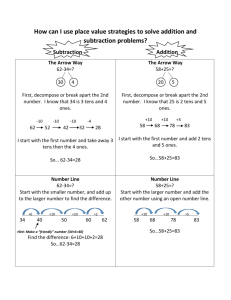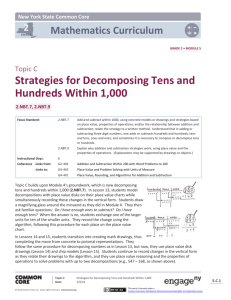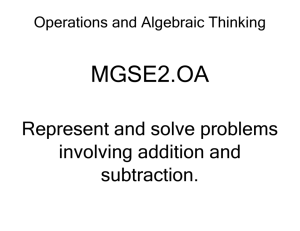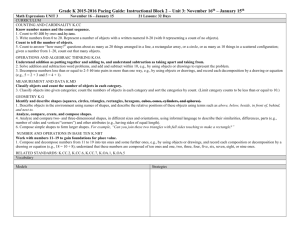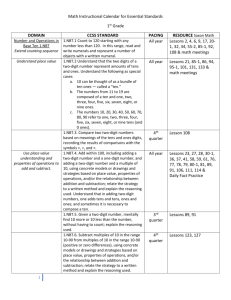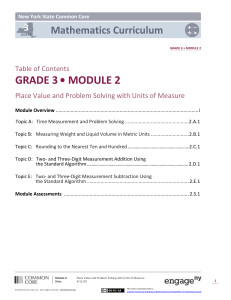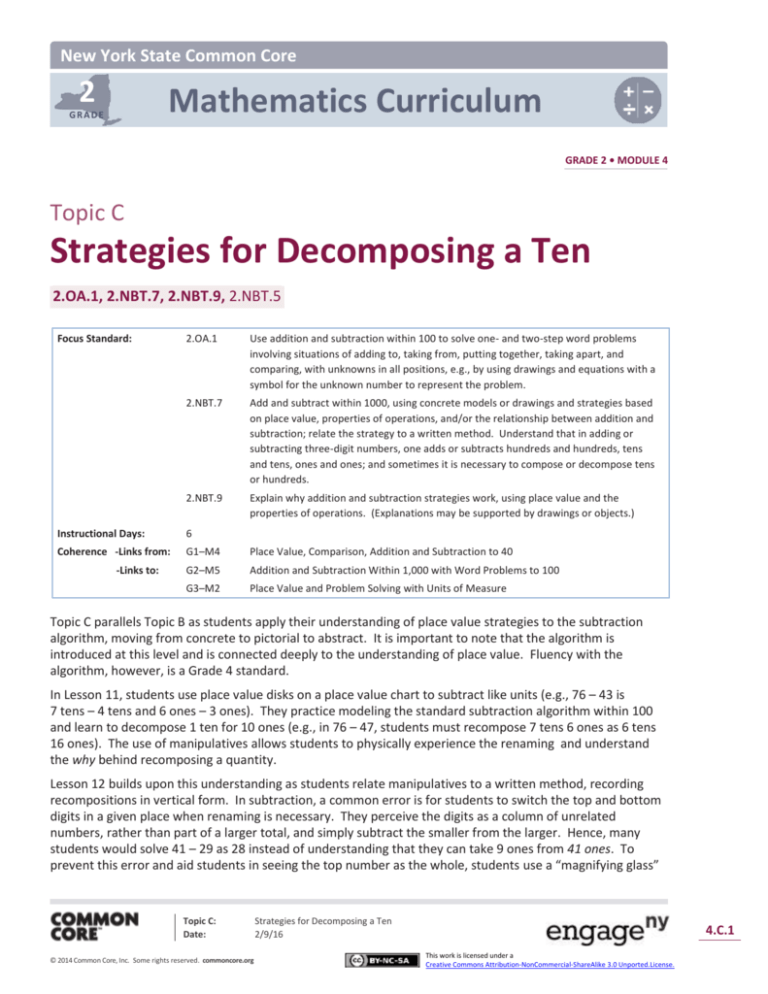
New York State Common Core
2
Mathematics Curriculum
GRADE
GRADE 2 • MODULE 4
Topic C
Strategies for Decomposing a Ten
2.OA.1, 2.NBT.7, 2.NBT.9, 2.NBT.5
Focus Standard:
2.OA.1
Use addition and subtraction within 100 to solve one- and two-step word problems
involving situations of adding to, taking from, putting together, taking apart, and
comparing, with unknowns in all positions, e.g., by using drawings and equations with a
symbol for the unknown number to represent the problem.
2.NBT.7
Add and subtract within 1000, using concrete models or drawings and strategies based
on place value, properties of operations, and/or the relationship between addition and
subtraction; relate the strategy to a written method. Understand that in adding or
subtracting three-digit numbers, one adds or subtracts hundreds and hundreds, tens
and tens, ones and ones; and sometimes it is necessary to compose or decompose tens
or hundreds.
2.NBT.9
Explain why addition and subtraction strategies work, using place value and the
properties of operations. (Explanations may be supported by drawings or objects.)
Instructional Days:
6
Coherence -Links from:
G1–M4
Place Value, Comparison, Addition and Subtraction to 40
G2–M5
Addition and Subtraction Within 1,000 with Word Problems to 100
G3–M2
Place Value and Problem Solving with Units of Measure
-Links to:
Topic C parallels Topic B as students apply their understanding of place value strategies to the subtraction
algorithm, moving from concrete to pictorial to abstract. It is important to note that the algorithm is
introduced at this level and is connected deeply to the understanding of place value. Fluency with the
algorithm, however, is a Grade 4 standard.
In Lesson 11, students use place value disks on a place value chart to subtract like units (e.g., 76 – 43 is
7 tens – 4 tens and 6 ones – 3 ones). They practice modeling the standard subtraction algorithm within 100
and learn to decompose 1 ten for 10 ones (e.g., in 76 – 47, students must recompose 7 tens 6 ones as 6 tens
16 ones). The use of manipulatives allows students to physically experience the renaming and understand
the why behind recomposing a quantity.
Lesson 12 builds upon this understanding as students relate manipulatives to a written method, recording
recompositions in vertical form. In subtraction, a common error is for students to switch the top and bottom
digits in a given place when renaming is necessary. They perceive the digits as a column of unrelated
numbers, rather than part of a larger total, and simply subtract the smaller from the larger. Hence, many
students would solve 41 – 29 as 28 instead of understanding that they can take 9 ones from 41 ones. To
prevent this error and aid students in seeing the top number as the whole, students use a “magnifying glass”
Topic C:
Date:
© 2014 Common Core, Inc. Some rights reserved. commoncore.org
Strategies for Decomposing a Ten
2/9/16
4.C.1
This work is licensed under a
Creative Commons Attribution-NonCommercial-ShareAlike 3.0 Unported.License.
NYS COMMON CORE MATHEMATICS CURRICULUM
Topic C 2 4
to examine the minuend. They draw a circle around the top number and add a handle (see image below).
Before subtracting, they look inside the magnifying glass at the whole number and determine if each digit is
big enough to subtract the number below it. If not, they decompose one of the next larger units to make ten
of the unit they need. In Lesson 13, this is used in conjunction with the chip model (shown below); students
record each change they make to their model while simultaneously using the algorithm.
In Lessons 14 and 15, students continue working with the chip model on their place value charts and follow
the same procedure for decomposing a ten and relating it to vertical form. Here, however, students subtract
a two-digit subtrahend from a three-digit minuend (e.g., 164 – 36). This provides practice working with and
drawing three-digit numbers without the complexity of decomposing a hundred.
As in Topic A, Topic C closes with a lesson that focuses on one- and two-step word problems within 100.
Students apply their place value reasoning, mental strategies, and understanding of compositions and
decompositions to negotiate different problem types with unknowns in various positions. Because two
different problem types (i.e., add to, take from, put together/take apart, compare) are often combined in
two-step word problems, some quantities will involve single-digit addends, especially when students are
working with the more challenging comparison problems. Students are encouraged to be flexible in their
thinking and to use drawings and/or models to explain their thinking. Students continue to use tape diagrams
to solve word problems, relating the diagrams to a situation equation (e.g., 8 + ____ = 41) and rewriting it as a
solution equation (e.g., 41 – 8 = ___), thus illustrating the relationship between operations. Students find
success when using their mental strategies of making a multiple of 10 and counting on (e.g., 9, 10, 20, 30 40,
41) as they experience the relationships between quantities within a context.
Topic C:
Date:
© 2014 Common Core, Inc. Some rights reserved. commoncore.org
Strategies for Decomposing a Ten
2/9/16
4.C.2
This work is licensed under a
Creative Commons Attribution-NonCommercial-ShareAlike 3.0 Unported.License.
Topic C 2 4
NYS COMMON CORE MATHEMATICS CURRICULUM
A Teaching Sequence Towards Mastery of Strategies for Decomposing a Ten
Objective 1: Represent subtraction with and without the decomposition of 1 ten as 10 ones with
manipulatives.
(Lesson 11)
Objective 2: Relate manipulative representations to a written method.
(Lesson 12)
Objective 3: Use math drawings to represent subtraction with and without decomposition and relate
drawings to a written method.
(Lesson 13)
Objective 4: Represent subtraction with and without the decomposition when there is a three-digit
minuend.
(Lessons 14–15)
Objective 5: Solve one- and two-step word problems within 100 using strategies based on place value.
(Lesson 16)
Topic C:
Date:
© 2014 Common Core, Inc. Some rights reserved. commoncore.org
Strategies for Decomposing a Ten
2/9/16
4.C.3
This work is licensed under a
Creative Commons Attribution-NonCommercial-ShareAlike 3.0 Unported.License.



